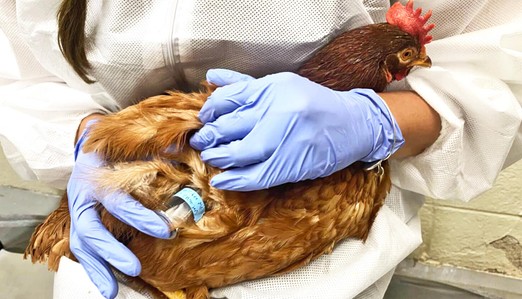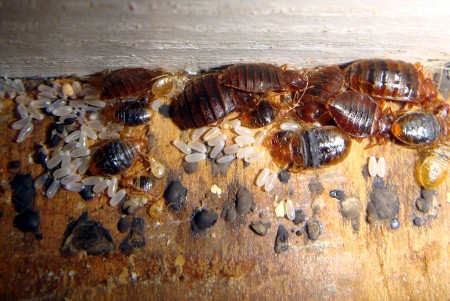Bed bugs are not only a problem for humans but also poultry. The first report of bed bugs in poultry houses was in early 1937, but reports of their sighting have increased recently. A study dated 2020 suggests that bed bugs are a re-emerging problem in poultry houses.
Bed bugs can cause serious harm to your chicken even though they do not transmit diseases. Nonetheless, you don’t have to worry. You will learn how to protect your chicken by reading this post.
Table of Contents
Can you find bed bugs in a poultry house?
Bed bugs are a huge problem for humans, but they are also becoming problematic in poultry houses. While there are no recent statistics on bed bugs in poultry houses, reports of their sighting are increasing rapidly. The bed bugs spread from homes, farm workers’ houses, and poultry houses.
Bed bugs are more problematic in broiler breeder houses than in domestic bird cages. Breeder facilities house roosters and hens in large numbers, providing an endless supply of blood for bed bugs. A poultry farm worker in Canada reported seeing numerous bed bugs. As a chicken breeder in the USA, take this as evidence that all is not well.
Bed bugs can hide in several spaces inside a poultry house, making it challenging to find them. In addition to cracks and crevices on walls, some of the places that provide perfect hiding spots for bed bugs include:
- Poultry nests
- Manure belts
- Egg belts
- Feeders
- Watering compartments
How bed bugs get into poultry houses
Bed bugs can hitch rides on shoes, clothing, production equipment, and egg boxes. Bed bugs can crawl from one place to another, but their crawling distance is limited to a 20-foot radius. They get into your poultry house by hitchhiking on people or poultry. If farm workers have bed bugs at home, they may unknowingly bring them.
Buying chicks from a hatchery also exposes your poultry house to bed bugs. If the incubator has bed bugs, they will hitchhike on the chicks and make their way into your poultry house. It is also best to avoid renting a transport vehicle to ferry chicks because public transportation is susceptible to bed bugs.
Signs of bed bugs in a poultry house
Bed bugs are tiny, nocturnal critters who habitually hide in cracks and crevices. The chances of finding a living bed bug in a poultry house full of hens, roosters, and chicks are minimal. Nonetheless, bed bugs leave behind several signs that can help you identify them. You should look for the following symptoms in you suspect an infestation in your poultry house:
- Dark brown spots: Bed bug fecal matter leaves dark brown spots because it contains digested human blood. The fecal matter also emits a weak, musty odor because the blood ingested contains iron. Identifying this scent in a poultry house is challenging because it is often smelly, owing to chicken excrement.
- Bed bug exoskeletons: Bed bugs have three life stages, and they must shed their exoskeletons at every phase of the nymph stage. If the infestation is large, you will notice exoskeletons in the bed bugs’ hiding spots. Even though you can see these exoskeletons with the naked eye, using a UV flashlight makes the task easier. Bed bug exoskeletons contain phosphors that emit a blue light when subjected to Ultra-Violet rays.
- Blood stains: Bed bugs in your poultry house will feed on the chickens’ blood. If a bed bug is crushed immediately after feeding, it leaves blood stains.
Point to Note: Even though bed bugs are good at hiding, you should inspect every nook and cranny in your poultry house. You should focus your search on floor joints, cracks in walls, inside electrical outlets, and areas where the floor and walls meet.
How bed bugs affect chickens in Poultry houses
Bed bugs can severely affect poultry, as they can feed on chickens continuously for up to one year. This can cause stress and health problems for the birds, including anemia, weight loss, and decreased egg production. Also, bed bugs can spread diseases, such as poultry red mites, which can cause further health problems for the birds.
Bed bug infestations lead to substantial economic losses for farmers, as the productivity of the birds is affected. As a poultry farmer, you should implement regular inspections and monitoring to detect and prevent infestations and take appropriate actions to eradicate them if you find them.
Little is known about the effects of bed bugs on poultry regarding meat and egg production. Nonetheless, researchers have uncovered several impacts of bed bugs on poultry. The most common ones include the following:
- Skin reactions and lesions on breasts and legs (You will not notice these quickly because feathers cover the chickens’ skin)
- Excessive feather loss
- In the case of severe infestation, excessive blood loss occurs, leading to anemia.
- Death of the birds if the infestation is severe
Point to Note: While there isn’t enough research on the effects of bed bugs on poultry production, it is safe to say it is negative. Like humans, poultry suffers distress in the face of bed bug attacks, leading to reduced production.
How to treat bed bugs in a poultry house
Bed bugs in poultry houses are incredibly challenging to treat because they have many hard-to-reach hiding spots, such as slats. Nevertheless, here are some treatment options that can help you to get rid of bed bugs in your poultry house:
Heat treatment
Heat is an effective tool to kill bed bugs in a poultry house, but several safety issues can arise when dealing with heat. Heat, when appropriately used, kills all life stages of bed bugs at temperatures above 140° F (60° C). While this treatment is a non-chemical method, heat can cause severe harm to poultry if you do not do it properly. You should research and learn how to apply heat treatment in a poultry house without harming your chicken. It is best to hire a professional to perform the treatment process if you are unsure how to do it.
There are several effective techniques for applying heat in a poultry house to kill bed bugs. The most common methods include the following:
Point to Note: It is advisable to relocate poultry before starting any treatment in the poultry house. You can apply diatomaceous earth on poultry to ensure they do not transmit bed bugs.
Cold treatment
Bed bugs die when exposed to extremely cold temperatures of 0° F (-18° C) for up to four days. A freezer cannot work in this scenario, but a cryonite machine can instantly treat bed bugs. This machine ejects powdered carbon dioxide at -110° F (-78° C), killing bed bugs instantly upon contact.
Point to Note: Cold treatment is only effective when dealing with low-level bed bug infestations since cryonite can only kill bed bugs upon contact.
Vacuuming
Vacuuming can be an effective method for eliminating bed bugs in poultry houses, particularly for low-level infestations. However, it does require proper identification of the bed bugs and their eggs, which can be challenging in a poultry house full of chickens. Before vacuuming, it’s crucial to inspect the entire poultry house thoroughly and identify all areas where the bed bugs are likely to be hiding, such as in cracks and crevices, around the edges of the walls and floors, and in the nesting boxes.
CAUTION: Several pesticides claim to treat bed bugs, but the problem is that bed bugs are resistant to most chemicals. In addition to that, chemicals in pesticides can be harmful to you and your poultry. If you must use pesticides, it is wise to seek the help of a qualified professional.
Preventing bed bugs in a poultry house
Preventing infestations is the best tool to fight bed bugs in a poultry house because they are challenging to eradicate. Here are some bed bug prevention tips that will help you in your fight against bed bugs:
- Proper education: You and your poultry farm workers must learn everything about bed bugs, including their appearance and signs. This will allow the workers to report possible infestations on time. Early identification is vital in all bed bug prevention endeavors.
- Bed bug monitoring: Investing in bed bug monitoring tools and traps helps to prevent bed bugs in your poultry house. Bed bug monitoring plays a significant role in early identification and prevention efforts.
- Sealing cracks and crevices: Sealing all cracks and crevices in your poultry house removes bed bugs’ potential hiding spots. This makes it hard for them to infest the poultry house without you or your workers noticing them early.
Final Thoughts
The first report of bed bugs in poultry houses was almost a century ago, but the situation is worsening. Dealing with these critters in a poultry house is difficult, but you shouldn’t lose hope. This post provides all the answers you need to know to protect your poultry, including:
- What bed bugs look like
- How they infest your poultry house
- How to prevent bed bugs in your poultry house
- How to treat bed bugs in your poultry house
FAQs
Can you use chemical pesticides to treat bed bugs in a poultry house?
Several pesticides claim to be effective against bed bugs but using them is not advisable. Bed bugs are resistant to most pesticides, and more importantly, they are to humans and poultry.
How can you prevent the spread of bed bugs from the poultry house to your home?
Change all your clothes and wash the dirty ones in a washing machine with high heat after leaving an infested poultry house. You should also avoid bringing items from the infested poultry house into your home.
Can disinfectants used in poultry houses kill bed bugs?
Disinfectants like bleach and Virkon can kill bed bugs only on direct contact.


